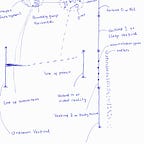Brain Science | Mental Health: Mindfulness | Meditation — Sensory to Memory Relays
Conceptually, there is a sense of smell component of meditation, just like there is a sense of touch component of physical activity.
Though breathing exercises are linked with lower blood pressure, higher supply of oxygen and others, the olfactory pathway is involved to benefit mindful breathing, even when there is ‘no smell’.
Breathing can be prioritized [attention] or pre-prioritized [close to or awareness] but every breath is in the reach of the sense of smell and beyond — to know.
Usually, incoming senses are — en route — to know. This means that smell, touch, taste, sight and hearing are the input stages, but must get to where they are known, to decide how to relate with them — as experiences with the external world. The knowing end of senses plays a key role in the decisions, by its limits or extents.
To know is memory. This means that [representations of] smells are stored in memory, just like internal senses have stores in memory, as well as things known — from the external world.
The same way some smells can get to memory to decide mood — good or bad, so is every breath prepared to make that change, depending on input.
Breathing exercise where there is ‘no smell’ uses a similar mechanism as smells in general, such that when in the memory, by finding that breathing [or the smell bearer] is prioritized, there is a rally to send what is incoming to multiple large stores, to seek what the request or ask might be.
So, in going around in the memory — while prioritized — it may use the attention to take away away the dominance of whatever is causing the mind problems.
More directly, whatever needs to be cleared from the mind is met with the [representation of the practice] in memory, getting the better of it.
Mindfulness, Meditation and Memory
Since thoughts are stored in memory — where all internal and external senses have representations — it is the center stage of exchange of experiences, for what leads in the moment.
There are different smells with small [unique] and large [similarity] stores. There is also the perception of what it means to experience ‘no smell’. But during breathing exercises, with controlled thought of breath, the purpose is to shift prioritization or attention in memory, from whatever else is on the mind, then persist, such that the input relays for a while, so that the large store of [the experience of calm] goes to the principal spot where it would have the most dominance, which may have removed that of the intrusiveness of thought, or of anxiety, depression and so on.
It is this prioritization power that also brings mindfulness and meditation their advantage in the memory, then sustaining it could be long enough to change the state of mind.
Also, because the calm large store is at the principal spot, it attracts small stores [pre-prioritized] of bodily functions, which may provide balance, like for blood pressure, heart rate and others.
It is the opposite of this that happens in psychosomatic affect, where the thought of something — getting known — could increase heart rate, or make breathing difficult, since the sequence makes it touch the store of anxiety, which may move to the principal spot then attract stores representing those functions, altering perceptions.
It is this conceptual action of stores in memory that also describes the power of mindfulness and meditation. It can be displayed, for specificity across devices, based on theoretical brain science.
